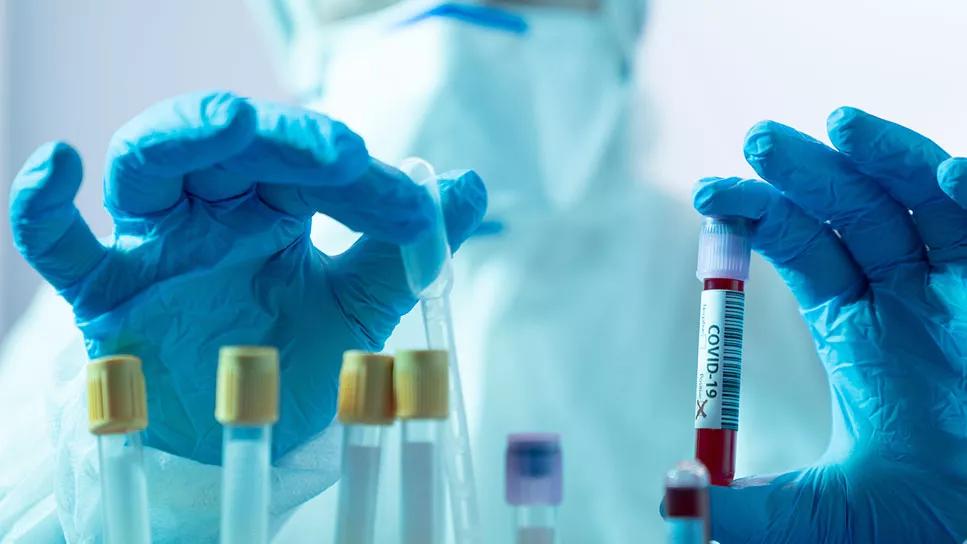Just like the flu, COVID-19 will continue to evolve every year

We’ve come a long way since the start of the COVID-19 pandemic. Where there was once a single, original strain of SARS-CoV-2 (the virus that causes COVID-19), there are now dozens of variants and subvariants that are circulating around the world. Like the flu, each variant and subvariant has different levels of severity and success. And that’s why we’ve now developed an annual COVID-19 vaccine.
Advertisement
Cleveland Clinic is a non-profit academic medical center. Advertising on our site helps support our mission. We do not endorse non-Cleveland Clinic products or services. Policy
It’s important to understand how and why these subvariants continue to evolve beyond their original mutations. And understanding those key components of COVID-19 helps us also understand the importance of getting vaccinated even as newer variants arise.
Microbiologist and pathologist Daniel Rhoads, MD, explains how subvariants work and what the latest news could mean for potential future surges of COVID-19.
The original virus has gone through several mutations since it was first detected in 2019 at the start of the COVID-19 pandemic. Although the original virus is no longer circulating, dozens of variants and subvariants continue to circulate around the world.
In the U.S. alone, the Centers for Disease Prevention and Control (CDC) continues to monitor dozens of variants currently circulating in the U.S., including up-and-coming variants of interest. Some of the variants tracked include:
According to the CDC, the omicron variant spreads faster and more easily than the original virus and the delta variant — and so far, that remains true as it continues to evolve with several subvariants that include HV.1 and EG.5.
Advertisement
"SARS-CoV-2 has demonstrated continual evolution since its emergence in humans. This evolution results in new variants that emerge and replace existing variants over time,” says Dr. Rhoads. “Since the emergence of omicron in 2021, these variants have shared similar disease symptoms and severity over time.”
Delta has been essentially replaced with omicron subvariants. This means delta is no longer an active variant of concern.
When delta was first discovered in July 2021, it spread quickly and hit hardest among younger populations (people in their 30s to 60s). Children and teenagers were also being infected, leading to surges in hospitals, serious illness and, for some, eventual death.
Omicron and its descendant lineages are the largest variants of concern in the U.S., mostly because it has had more than 50 and counting mutations in its genetic code since it was discovered. Responsible for nearly 100% of COVID-19 cases in the U.S., more than 30 omicron subvariants are circulating that are being tracked by the CDC, including:
For example, EG.5, according to the World Health Organization (WHO), was a subvariant that was detected in more than 51 countries between February 2023 and August 2023. And according to the CDC, as of November, EG.5 was detected in more than 20% of all U.S. cases of COVID-19.
XBB.1.5 is a direct descendant of EG.5 — meaning it carries characteristics from that omicron subvariant. As of November 2023, it’s also responsible for 29% of COVID-19 cases in the U.S. — making it the dominant strain circulating. Like other omicron subvariants, it does a good job of evading your body’s immune system. But like those other variants, the latest updated COVID-19 vaccine can still target it and increase your protection against infection.
“EG.5 is a subvariant that has emerged within the last year,” says Dr. Rhoads. “We don’t have much information yet, but it appears to be much like the same omicron subvariants that came before it. Even the symptoms are generally the same or similar, but the caveat is that the symptoms can look different in any one individual. And distinguishing infections like COVID and influenza by symptoms alone is not reliable.”
That means you can be asymptomatic or have any number of symptoms that include:
How one person handles infection from EG.5 may be entirely different from how someone else handles it, so it’s important to remain aware of any new symptoms you experience.
Advertisement
Viruses are ever-changing in an effort to survive and spread. All viruses are made up of a bundle of genetic material (either DNA or RNA) that’s covered by a protective coating of proteins. Once a virus gets into your body — usually through your mouth or nose — it latches onto one of your cells. The virus’s DNA or RNA then enters your cell, where it can make copies of itself that go off and infect other cells. If the virus can copy itself and hijack enough of your cells without being wiped out by your immune system, that’s how you get sick.
With each new mutation that occurs in a virus, new characteristics arise. Some of these mutations cause the virus to stop working effectively, forcing it to die off or become less transmissible. Other mutations can cause the virus to become less detectable by our immune systems, become more transmissible or evade our immune system’s memory.
“I think of it like a dice roll: Every time somebody is infected, there are millions of new viral particles that are put out and there are some mistakes that can be made during the replication of the virus,” explains Dr. Rhoads. “Sometimes, these mistakes are actually helpful. But usually, they’re not.”
The CDC compares the mutation process to the branches of a tree: With each new mutation, a new branch grows, allowing the virus to grow in new directions. From those branches, there are stems, or subvariants, that are further mutations made on the backbone of the main variant. HV.1, for example, is a mutation of the omicron “parent” virus.
Advertisement
That said, you can still get an infection even if you’ve been vaccinated.
“HV.1 has a lot of mutations in its spike protein,” states Dr. Rhoads. “It’s thought that those mutations likely provide some immune escape, meaning if you have an underlying immunity due to vaccination or previous infection, this virus seems like it looks different enough that it can still cause infection.”
Another way to think about variants, subvariants and virus lineages is thinking about a car.
“The original virus, SARS-CoV-2, is like the make of a car,” illustrates Dr. Rhoads. “Then, there are different models that come out that are a little bit different, even though it’s from the same designer and it’s basically the same thing. Omicron and its subsequent variants are more contemporary models of the original virus.”
And when you add special features to that unique make and model, you’ve got a new subvariant.
Now that we know COVID-19 peaks in the fall and winter like other respiratory viruses during respiratory season, it’s to be expected that we’ll have a surge in COVID-19 cases. And while the availability of at-home testing has made COVID-19 detection possible, and infections less likely, if you’ve been vaccinated for COVID-19 and still get infected, you’re less likely to show symptoms and, therefore, less likely to test for COVID-19.
Advertisement
In short, as HV.1 and future subvariants continue to appear, the potential for peaks in COVID-19 cases is always possible, especially during respiratory season.
The contagiousness of newer variants and subvariants is all the more reason to stay careful, even as most states roll back social distancing guidelines. While it’s possible to get reinfected, the number of cases that result in serious illnesses, hospitalizations or death is relatively low because vaccines are working to suppress the strength and spread of COVID-19. There are also new treatments for COVID-19, making the recovery process even more manageable.
“Staying away from others who are sick, staying away from others when you are sick and staying up to date on vaccines are the best tools we have for preventing respiratory virus infections like COVID, influenza and RSV,” states Dr. Rhoads.
The same protocols apply to HV.1 and EG.5 that have applied to every other variant and subvariant of the coronavirus: The best preventive measures include getting vaccinated, wearing a mask during times of high transmission, staying 6 feet apart, washing hands often and avoiding people who are sick.
Learn more about our editorial process.
Advertisement

The short answer: It’s complicated, but the basic care precautions still prevail, like washing your hands and isolating if you’re sick

They can feel like a typical headache or a migraine headache, but the pain can last for weeks to months

Any large social gathering — from a family birthday party to an indoor music concert — has the potential to spread serious infection

It’s important to connect with a healthcare provider, get quality sleep and balance your activities with your energy levels

The duration varies, but symptoms can linger for a few days up to a couple weeks or more

Vaccination is best for prevention, but if you get sick with COVID-19, treatments are available

The virus lives best in humans, but it can last on hard surfaces, like doorknobs and railings

Like the flu and RSV, COVID-19 cases are rising seasonally

Type 2 diabetes isn’t inevitable with these dietary changes

Applying a hot or cold compress can help with pain